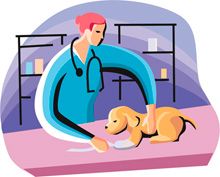A painless veterinary career choice
Obtaining certification as a Certified Veterinary Pain Practitioner will not only help you provide the next level of care to patientsit may also help you reach a new level of personal and professional growth.

GETTYIMAGES/Stock FoundryHey you. Yes, you!
Are you a technician? Are you feeling stuck in a career rut? Do you ever wonder about other opportunities for technicians? Of course you do-because technicians are educated, dedicated and compassionate people who always strive to give the best to their patients.
Gone are the days of the technician simply holding an animal or preparing vaccines. Now technicians are using their superpowers to further their education and become dynamic participants in the field of veterinary medicine to offer high-quality patient care.
The painful truth
Today technicians can pursue further training and specialization in many avenues, including dentistry, anesthesia, internal medicine and emergency and critical care-and also in the field of pain management.
Technicians and veterinarians involved in pain management help strengthen the practice's bond with animals and with clients. As pain management has become an important specialty area in human medicine, it's led to a greater awareness of pain in animals. Pet parents want the best for their furry family members, and that includes top-of-the-line pain management.
In veterinary medicine we now know that pain is best managed through an interdisciplinary approach, and we can best achieve effective pain management through cooperation, sharing knowledge and the collective wisdom of veterinary professionals from many disciplines.
Certification deciphered
The International Veterinary Academy of Pain Management's program grants the title of Certified Veterinary Pain Practitioner (CVPP) for veterinarians and licensed technicians or Certified Animal Pain Practitioner (CAPP) for physical therapists and physical therapist assistants with certification in canine rehabilitation for candidates who complete the program and pass a certification test. The certification program emphasizes the value of the many disciplines capable of enhancing patient comfort and quality of life and educates about a variety of modalities. These areas include:
> Analgesic drug therapies
> Analgesic adjunct therapies
> Physical rehabilitation methods
> Complimentary alternative therapies, such as acupuncture and massage
By using a multimodal approach the CVPP can use analgesic drug therapies along with physical therapy techniques such as massage, hydrotherapy and acupuncture to create a multidimensional pain management plan.
Put your certification to work
After obtaining a CVPP, the technician can work with pet owners and veterinarians to provide the best pain management plans for patient in these ways:
1. Assess the patient's current status and pain management regime and-together with the owner and veterinarian-create a pain management plan specific to that patient for the best overall outcome.
2. Assist in the acute pain management setting helping clinics to create protocols under a veterinarian's guidance for postoperative pain scoring and proper analgesic techniques for acute surgical pain.
3. Act as a point person the pet owner can contact and relay information to about the pet's progress. The CVPP can then take this information and work with the veterinarian to make changes to the analgesic plan as necessary to ensure the best outcome for that patient.
By obtaining your CVPP you can also help in the continuing education of your clients and team members. Many veterinary professionals who have obtained the CVPP designation go on to write magazine articles, teach online courses and lead seminars on various pain management topics.
There are so many opportunities for the veterinary technicians when it comes to pain management. Technicians can further their education and become certified in acupuncture, massage therapy, reiki and various other pain management modalities.
By reaching the goals associated with CVPP certification, veterinary technicians can increase their patients' safety and comfort, increase the overall morale at your practice, educate pet owners on the importance of proper pain management and increase client compliance in this area.
Now, it's not all sunshine and puppy kisses. Obtaining your CVPP will require a big time commitment. And you need to be at a practice that supports technicians being an active part of the medical process. But if you do jump through the hoops, your patients will have more comfortable recoveries from surgery and older animals will cope with chronic pain better because of your efforts.
Tasha McNerney, BS, CVT, is a member of the IVAPM, and she is currently pursuing her CVPP. She works as a technician at Rau Animal Hospital in Glenside, Pennsylvania.